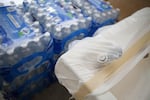
A covered drinking fountain sits next to cases of bottled water at Llewellyn Elementary in Sellwood, in Southeast Portland.
Bradley W. Parks / OPB
The Portland Water Bureau is taking immediate steps to reduce the amount of lead in the water at taps across the Portland metro area. The move comes after a routine check of at-risk homes found too much lead in the water this fall, and state regulators ordered the Water Bureau to take immediate action.
The Water Bureau submitted a plan to the Oregon Health Authority on Friday detailing changes it is making. Most significantly it will bump up the pH of its water just a little, from 8 to 8.2, by July 2017.
Corrosive water can cause lead to leach out of ordinary household pipes and plumbing fixtures and into drinking water, so one way to reduce lead exposure across a city is to change the pH of its water by adding chemicals.
"In Portland, the primary source of lead in water is from plumbing in homes and buildings. We have never used lead service lines," wrote Portland Water Bureau Director Michael Stuhr, in a press release that accompanied the lead reduction plan.
The Water Bureau also said it would "investigate the feasibility" of a program to help customers pay to replace pipes and plumbing fixtures that contain lead. The bureau did not follow a suggestion from the EPA that it install temporary chemical feed systems at pump stations and storage tanks to control pH.
"Adding chemicals that have not been tested in the system is not recommended and could cause unintended consequences," the Water Bureau noted.
Related: Why Portland's Water Hasn't Gotten The Lead Out
The decision to immediately increase corrosion treatment comes after the city has repeatedly failed to meet EPA standards for lead in drinking water, and after federal regulators raised concern about the potential for lead in drinking water at schools and pushed for more aggressive corrosion control.
A corrosion study in 1994, for example, recommended increasing the pH of the city's water to 9.0 for optimal lead control.
Instead, concerned about the cost of aggressive chemical treatment and the reaction from a city notoriously averse to changes to its water system, the Water Bureau pursued a program that combines minimal water treatment with a range of other strategies to reduce lead exposure citywide.
The bureau provides free lead-in-water tests to its customers and funds public education and community outreach on lead exposure.
But that strategy has failed to adequately control lead levels at the taps of high-risk homes in the Portland area, which have exceeded EPA lead in water standards three times since 2005, most recently in Fall 2016.
The Portland Water Bureau is also working on a pilot study testing various lead treatment strategies, and Director Michael Stur says he will recommend more significant water treatment changes to the city council next spring.
Public health experts say no level of exposure to lead is safe for children or pregnant women. Lead paint is the most significant source of lead exposure and lead poisoning in the Portland area. Home demolitions, which aren't subject to the same lead mitigation requirements as home remodels, have become a particular source of community concern.
According to the Portland Water Bureau, from 2013 to 2016, more than 19,000 blood lead tests were conducted in Multnomah County. None of the 184 elevated blood level investigations were traced to lead in drinking water from any source.
